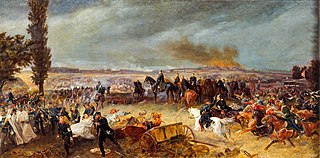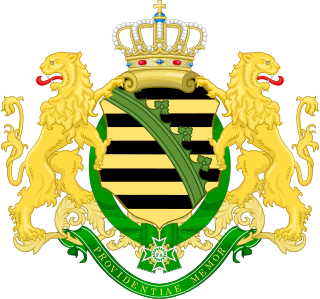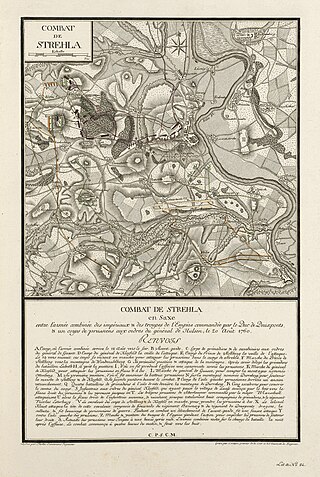
The Battle of Rossbach took place on 5 November 1757 during the Third Silesian War near the village of Rossbach (Roßbach), in the Electorate of Saxony. It is sometimes called the Battle of, or at, Reichardtswerben, after a different nearby town. In this 90-minute battle, Frederick the Great, king of Prussia, defeated an Allied army composed of French forces augmented by a contingent of the Reichsarmee of the Holy Roman Empire. The French and Imperial army included 41,110 men, opposing a considerably smaller Prussian force of 22,000. Despite overwhelming odds, Frederick managed to defeat the Imperials and the French.

The Battle of Königgrätz was the decisive battle of the Austro-Prussian War in which the Kingdom of Prussia defeated the Austrian Empire. It took place on 3 July 1866, near the Bohemian city of Hradec Králové and village of Sadová, now in the Czech Republic. It was the single largest battle of the war, and the largest battle in the world since the Battle of Leipzig in 1813.

The Silesian Wars were three wars fought in the mid-18th century between Prussia and Habsburg Austria for control of the Central European region of Silesia. The First (1740–1742) and Second (1744–1745) Silesian Wars formed parts of the wider War of the Austrian Succession, in which Prussia was a member of a coalition seeking territorial gain at Austria's expense. The Third Silesian War (1756–1763) was a theatre of the global Seven Years' War, in which Austria in turn led a coalition of powers aiming to seize Prussian territory.

Friedrich Wilhelm Freiherr von Seydlitz was a Prussian officer, lieutenant general, and among the greatest of the Prussian cavalry generals. He commanded one of the first Hussar squadrons of Frederick the Great's army and is credited with the development of the Prussian cavalry to its efficient level of performance in the Seven Years' War. His cavalryman father retired and then died while Seydlitz was still young. Subsequently, he was mentored by Margrave Frederick William of Brandenburg-Schwedt. Seydlitz's superb horsemanship and his recklessness combined to make him a stand-out subaltern, and he emerged as a redoubtable Rittmeister in the War of Austrian Succession (1740–1748) during the First and Second Silesian wars.

The Battle of Lobositz or Lovosice also Lowositz on 1 October 1756 was the opening land battle of the Third Silesian War and the wider Seven Years' War. Frederick the Great's 28,000 Prussians were prevented by 33,000 Austrians under Maximilian Ulysses Count von Browne from continuing their invasion into the rich Bohemian plain, forcing Frederick to ultimately fall back north into Saxony for the winter.

The Battle of Maxen was a battle at Maxen, in the Electorate of Saxony during the Third Silesian War. It resulted in surrender of a Prussian corps.

The Battle of Mollwitz was fought by Prussia and Austria on 10 April 1741, during the First Silesian War. It was the first battle of the new Prussian King Frederick II, in which both sides made numerous military blunders and King Frederick II of Prussia fled the battlefield, but the Prussian Army still managed to attain victory. This battle cemented Frederick's authority over the newly conquered territory of Silesia and gave him valuable military experience.

The Battle of Hohenfriedberg or Hohenfriedeberg, now Dobromierz, also known as the Battle of Striegau, now Strzegom, was one of Frederick the Great's most admired victories. Frederick's Prussian army decisively defeated an Austrian army under Prince Charles Alexander of Lorraine on 4 June 1745 during the Second Silesian War.

Leopold I, Prince of Anhalt-Dessau was a German prince of the House of Ascania and ruler of the Principality of Anhalt-Dessau from 1693 to 1747. He was also a Generalfeldmarschall in the Prussian Army. Nicknamed "the Old Dessauer", he possessed good abilities as a field commander, but was mainly remembered as a talented drillmaster who modernized the Prussian infantry.

Hans Joachim von Zieten, sometimes spelled Johann Joachim von Ziethen,, also known as Zieten aus dem Busch, was a cavalry general in the Prussian Army. He served in four wars and was instrumental in several victories during the reign of Frederick the Great, most particularly at Hohenfriedberg and Torgau. He is also well known for a raid into the Habsburg territories during the Second Silesian War, known as Zieten's Ride. After engaging in a reputed 74 duels, and fighting in four wars, he died in his bed at the age of 86.

The Battle of Saalfeld took place on 10 October 1806, at which a French force of 12,800 men commanded by Marshal Jean Lannes defeated a Prussian-Saxon force of 8,300 men under Prince Louis Ferdinand. The battle took place in Thuringia in what was the Ernestine duchy of Saxe-Coburg-Saalfeld. The battle was the second clash in the Prussian Campaign of the War of the Fourth Coalition.

The Second Silesian War was a war between Prussia and Austria that lasted from 1744 to 1745 and confirmed Prussia's control of the region of Silesia. The war was fought mainly in Silesia, Bohemia, and Upper Saxony and formed one theatre of the wider War of the Austrian Succession. It was the second of three Silesian Wars fought between Frederick the Great's Prussia and Maria Theresa's Austria in the mid-18th century, all three of which ended in Prussian control of Silesia.

The Battle of Soor was a battle between Frederick the Great's Prussian army and an Austro-Saxon army led by Prince Charles Alexander of Lorraine during the Second Silesian War. The battle occurred in the vicinity of Soor, also known as Hajnice, in the modern day Czech Republic. The battle started with a failed Austrian surprise attack on the outnumbered Prussians. Despite initial setbacks the Prussian army managed to defeat the Austrians, due to an unexpected attack from a reserve regiment that refused to follow Frederick's orders.

The Battle of Kesselsdorf was fought on 15 December 1745, between the Kingdom of Prussia and the combined forces of the Archduchy of Austria and the Electorate of Saxony during the part of the War of the Austrian Succession known as the Second Silesian War. The Prussians were led by Leopold I, Prince of Anhalt-Dessau, while the Austrians and Saxons were led by Field Marshal Rutowsky. The Prussians were victorious over the Royal Saxon Army and the Imperial Army of the Holy Roman Emperor.

The Royal Prussian Army served as the army of the Kingdom of Prussia. It became vital to the development of Prussia as a European power.

The Battle of Freiberg was fought on 29 October 1762 and was the last great battle of the Third Silesian War.

The Royal Saxon Army was the military force of the Electorate (1682–1807) and later the Kingdom of Saxony (1807–1918). A regular Saxon army was first established in 1682 and it continued to exist until the abolition of the German monarchies in 1918. With the formation of the Confederation of the Rhine by Napoleon the Royal Saxon Army joined the French "Grande Armée" along with 37 other German states.

The Battle of Schleiz took place on 9 October 1806 in Schleiz, Germany between a Prussian-Saxon division under Bogislav Friedrich Emanuel von Tauentzien and a part of Jean-Baptiste Bernadotte's I Corps under the command of Jean-Baptiste Drouet, Comte d'Erlon. It was the first clash of the War of the Fourth Coalition, part of the Napoleonic Wars. As Emperor Napoleon I of France's Grande Armée advanced north through the Franconian Forest it struck the left wing of the armies belonging to the Kingdom of Prussia and the Electorate of Saxony, which were deployed on a long front. Schleiz is located 30 kilometers north of Hof and 145 kilometers southwest of Dresden at the intersection of Routes 2 and 94.

In the Battle of Halle on 17 October 1806 a French corps led by Jean-Baptiste Bernadotte fought the Prussian Reserve under Eugene Frederick Henry, Duke of Württemberg. The French defeated their opponents, forcing the Prussians to retreat northeast toward Dessau after suffering heavy losses. The clash occurred in the War of the Fourth Coalition, part of the Napoleonic Wars. The city of Halle is located about 30 kilometers northwest of Leipzig on the Saale River.

The Battle of Strehla was a military engagement fought during the Seven Years' War between the Kingdom of Prussia and Austria. The Austrian army attacked an outnumbered Prussian corps but was repulsed. The battle was fought near the town of Strehla in Saxony, Germany.





















